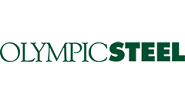Steel Mills

Olympic Posts Strong Q1, Predicts Solid Q2 Even if Prices Slip
Written by Michael Cowden
May 6, 2022
Olympic Steel Inc. posted strong first quarter earnings despite falling carbon steel prices earlier in the year.
And the Cleveland-based service center expects the good times to carry into the second quarter even if steel prices slip.
![]()
“We’ve worked hard to diversify our business, reduce our exposure to cyclical risk, and drive operational efficiencies,” Olympic Steel CEO Richard Marabito said on a conference call with analysts on Friday, May 6.
“Our ability to deliver near-record profitability in a challenging carbon pricing environment shows that these efforts are working,” he said.
Marabito said in an exclusive interview with SMU last year that the company’s acquisition of Shaw Stainless & Alloys, and its sale of its Detroit location to Venture Steel, were part of an effort to be less dependent on Midwestern carbon flat-rolled steel markets.
Company executives on the call on Friday said that only about half (54%) of first quarter sales were of carbon flat-rolled products. The balance were specialty metals (29%) and pipe and tube (17%).
All told, Olympic reported net income of $37.2 million in the first quarter of 2022, up 69% from $22 million in the first quarter of 2021 on revenue that rose 50% to $696.3 million over the same period.
The financial gains came even though Olympic sold fewer tons of carbon flat products in the first quarter of this year: 206,083 tons, down 14% from 239,848 tons in the first quarter of last year.
One reason: Average selling prices on the carbon side were $1,842 per ton ($92.10 per cwt) in the first quarter of 2022, up 79% from $1,027 per ton in the first quarter of last year, according to figures released with earnings data.
Futures markets indicate that hot-rolled coil prices will slip in the months ahead, chief financial officer Richard Manson said. “We’re in a period where it’s just trying to find its footing. … and then hopefully stabilizes.”
And while prices might fall from recent peaks, they are likely to “remain elevated” compared predictions last fall of sharply lower tags, he said.
Olympic in the meantime wants to trim its inventories. “We’re in relatively good shape today, but … we have some work to do to just bring it down a little bit,” Marabito said.
The company plans to continue to “aggressively” pursue acquisitions. One hurdle to those is volatility in valuations, which plunged following the outbreak of the pandemic and have since surged. That makes agreeing to a price more difficult.
But the big picture remains positive for domestic service centers, even once you factor in black swan events like the war in Ukraine. The war could create permanent changes in supply chains. Namely, they will become “closer to home,” which should benefit US manufacturing in general and Olympic in particular, Marabito said.
As for end-use demand, it remains steady but has been stymied by supply chain problems and parts shortages across multiple sectors. The chip shortage holding back automotive, for example, is unlikely to be resolved this year, Olympic president and chief operating officer Andrew Greiff said.
Another can being kicked into next year is demand from infrastructure spending. “We’re not seeing that yet,” Marabito said. “We’re looking more towards that as a 2023 … boost to demand.”
President Biden signed an infrastructure spending bill into law in November. But market participants have noted that it’s hard to point to any significant increase in demand to date from that spending.
By Michael Cowden, Michael@SteelMarketUpdate.com

Michael Cowden
Read more from Michael CowdenLatest in Steel Mills

Cliffs idles Steelton, Riverdale, and Conshohocken operations
Cliffs has idled facilities in Riverdale, Ill., and Conshohocken and Steelton, Pa.

Radius loss narrows, volumes climb in ‘healthy’ West Coast market
Stronger steel demand in the Western US, rising scrap flows, and improved rolling mill utilization drove sequential gains for Portland, Ore.-based Radius Recycling.

AISI: Raw steel production backs off multi-year high
US raw steel output edged lower last week after hitting a multi-year high in mid-June, according to the American Iron and Steel Institute (AISI).

Private equity firm Atlas Holdings to acquire Evraz North America
Atlas Holdings said it has signed a definitive agreement to acquire Evraz North America (Evraz NA). The Greenwich, Conn.-based private equity firm said it expects the deal for the Chicago-based steelmaker to close in the second quarter of 2025 subject to various closing condition.

Granite City Works must remain open and other terms of the Nippon-USS deal
SEC documents also name Trump specifically as having veto power certain decisions are part of the “Golden Share” provision.
